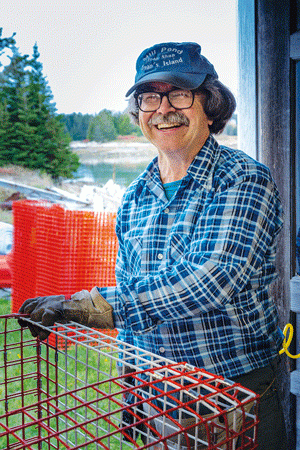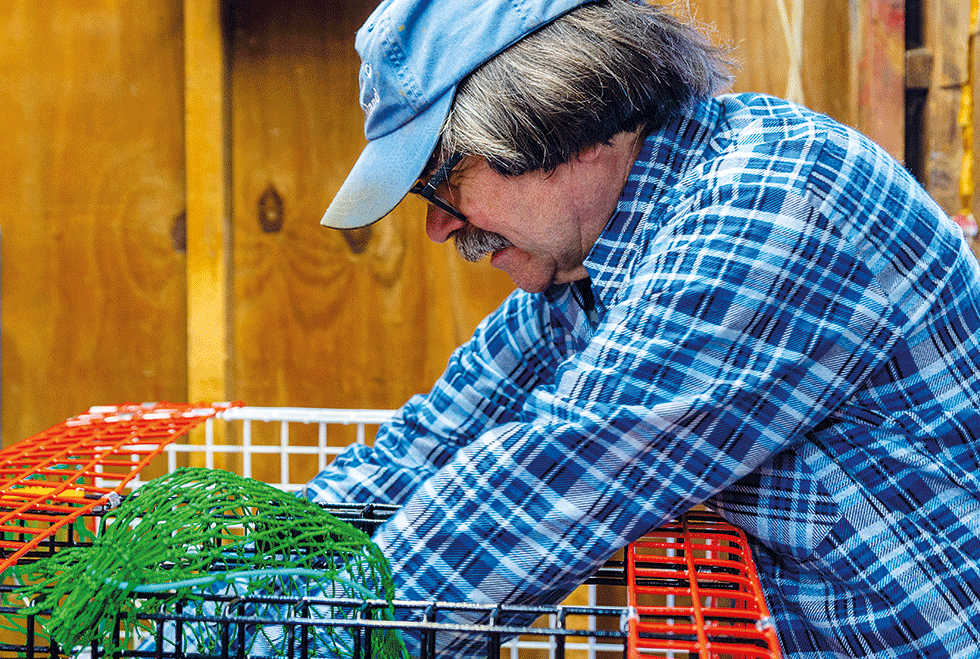
DALE JOYCE/HARBORVIEW STUDIO
Donnie Carlson
By Jennifer Helman/Photos By Dale Joyce
Many people in the lobster industry see fishing as a birthright. They fish because their father fished, and maybe his father before him. Donnie Carlson started on that familiar path, but took an unexpected turn 30-plus years ago.
As a boy, Carlson, a life-long resident of Swan’s Island, worked as sternman for his father during lobster and scallop season. Unlike most island boys, though, he suffered from terrible motion sickness. While he loved working outdoors, he decided early on he wouldn’t have a career on the water.
After graduating high school, Carlson went to college for a degree in forestry, opting for the two-year program. But in looking for a job in this limited field, he found himself competing with graduates of the four-year program. He was offered one position searching for trees suitable for electric and telephone poles. He wasn’t sure he’d find sampling hundreds of trees a day as satisfying as he’d hoped for in a job. So, he returned home to the island and immediately started working as a sternman again.
“If you want to live on the island, it’s the work you do,” he explained.
For a couple of years, Carlson found himself struggling through the fishing season. In the winter months, he picked up whatever side jobs were available—painting, carpentry, and he even delivered the mail for a while. But one of these side jobs accidentally led to a profession.
Another lobsterman on the island had invested in all the wire trap-making equipment and tried to make standard traps. He found the market demanded custom-made traps, so he decided to sell the set-up. Carlson and his brother bought the equipment and in the early 1980s built their own shop.
Today’s traps don’t look dramatically different than those Carlson built in the 1980s. A few hold-outs were still using wood traps then, but the majority had already switched to vinyl-coated wire. The heads—the netting inside the trap—have gone from being hand-knit to machine made.
Perhaps the biggest change in the trap-building industry has been in the tools used. Now that pneumatic equipment is accessible to even the smallest shop, production has become much more efficient.
Carlson learned from his predecessor’s failure that standard traps were not the way to go. He works with each customer to customize the traps, or as fishermen call it, the gear. From the color of the vinyl-coated wire to the size and placement of the vents and heads, no two orders are the same.
Many customers have a tried and true formula they repeat year after year. Others try the latest as soon as it comes out— new head styles and spacing, and even colors.
“They always want to see what might fish better,” Carlson said.
The shop’s production is so well refined, it looks like a one-man assembly line. Once he works out the process for a new design, it takes him approximately one hour to complete one trap.
A typical order today is 50-100 traps. Carlson has had some customers stay with him since he started and others who have come and gone. He’s noticed that the older generation is starting to slow down and buying fewer traps, while the younger generation often make their own traps as a way to cut down on costs.
He still has plenty of business, and adds: “I’m not ready to talk retirement yet.”





